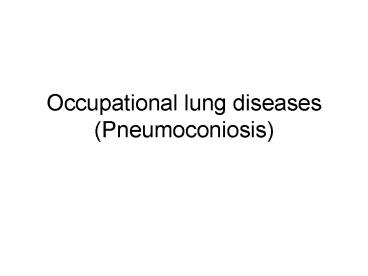Occupational lung diseases (Pneumoconiosis) - PowerPoint PPT Presentation
1 / 27
Title:
Occupational lung diseases (Pneumoconiosis)
Description:
Occupational lung diseases (Pneumoconiosis) * * * Pneumoconioses is a group of lung diseases which result from inhalation of dust in certain occupations. – PowerPoint PPT presentation
Number of Views:2521
Avg rating:3.0/5.0
Title: Occupational lung diseases (Pneumoconiosis)
1
Occupational lung diseases(Pneumoconiosis)
2
- Pneumoconioses is a group of lung diseases which
result from inhalation of dust in certain
occupations.
3
Classification of Pneumoconioses
4
1. Benign Pneumoconioses
- Dust could not Produce fibrosis
- Examples include
- Baritosis pure Barium sulphate and oxide
- Siderosis ferric oxide
- Titanosis titanium oxide
- Chalkosis calcium salts
5
2. Simple Pneumoconioses
- Inhaled dust causes only minimal fibrosis
- Examples
- Silicatosisinhalation of complex silicates (not
free silica) eg clays - Vegetable dust pneumoconioses
- Mill fever organic dust
- Byssinosis cotton dust
- Farmers lung moldy hay
- Grain asthma grain dust
- Tamarind asthma tamarind seed dust
6
3. Complicated Pneumoconioses
- Produce Progressive Massive Fibrosis
- Examples
- Silicosis inhalation of free crystalline Silica
SiO2 - Asbestosis inhalation of fibrous tri-magnesium
silicates - Talcosis inhalation of talc powder
- Coal miners pneumoconiosis inhalation of coal
dust
7
Factors affecting the development of disease by
deposited dust particles in the respiratory system
8
- Nature and chemical composition
- Size of dust particles
- Concentration of dust in atmosphere
- Duration of exposure
- Individual susceptibility
9
1. Nature and chemical composition
- Organic dusts
- e.g. Cotton dust, grain dust
- Asthma bronchitis, non distinguishable
- Inorganic dusts
- E.g. Silica, Asbestos
- Massive progressive fibrous reaction in the lung
10
2. Size of dust particles
- 10-5 µ Removed from upper respiratory tract
- 5-3 µ Deposited in the mid respiratory tract
- 3-1 µDeposited directly in the alveoli
- lt 1 µ Move in and out of the alveoli with air,
- may be deposited in alveolar wall by impaction,
or being caught by alveolar movement
11
Size of Dust
10- 5 µ - Upper Respiratory tract
5 - 3 µ Mid respiratory tract
3 - 1 µ Alveoli
12
Study of some common Pneumoconioses
- 1. Silicosis
13
Definition
- Pathological condition of the lung due to
inhalation of particulate matter containing free
silica or uncombined silica (SiO2)
14
Common occupations with exposure to silica
- Mines
- Porcelain
- Sand bricks industry
- Glass industry
- Gun industry
- Grinding of metals using sand stone
15
Pathology
- Fibrotic nodules develop by a particular process
in which fibrous tissue is laid down in
concentric rings around a central core of silica
particles as an onion
16
silicosis
Healthy lung
17
Manifestions
- Symptoms
- shortness of breath while exercising
- fever
- occasional bluish skin at ear lobes or lips
- fatigue
- loss of appetite
18
There are three kinds of silicosis, based on
amount of exposure and length of time
- 1.Chronic
- occurs after 10 or more years of mild
overexposure to silica - the most common of all types
- may go undetected for years
- 2. Accelerated
- develops between 5 and 10 years of moderate
overexposure - 3. Acute
- develops within weeks up to five years due to
breathing very large amounts of silica
19
Chest X-ray (Silicosis)
Nodular shadows of different sizes
20
Study of some common Pneumoconioses
- 2. Asbestosis
21
Definition
- Parenchymal lung fibrosis with or without pleural
involvement due to inhalation of asbestos fibres. - It is more dangerous than silicosis as it
predisposes to bronchogenic carcinoma and
mesothelioma of the pleura and peritoneum
22
Asbestos fibers
23
Asbestosis
24
Complications
- Bronchogenic carcinoma
- Mesothelioma
25
Prevention of Pneumoconioses
26
Environmental measures
- Substitution of harmful dusts by non harmful
substances - Seggregation of dangerous processes
- Enclosure of machines releasing dust
- Ventillation
- Wetting precipitation of dust by spraying water
- Vaccum cleaning
- Protective devices masks
27
Medical measures
- Preemployment examination
- Periodic examination
- Health education
- Nutrition
- Prohibition of smoking































